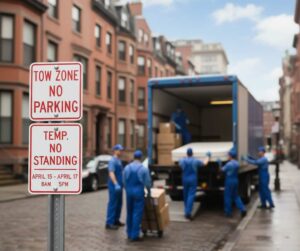Most moving stress comes from ordinary things that snowball, packing that needs an extra weekend, a utility start date that slips, or a delivery window that arrives before anyone has found the bed hardware. The difference between a frustrating move and a manageable one usually comes down to a handful of decisions made weeks before the truck arrives.
This guide walks through the most common moving mistakes, why they happen, and how to sidestep them without adding stress to an already busy process.
Whether you’re moving across town or across the country, the patterns are surprisingly consistent. These problems trace back to timing, communication, or assumptions that didn’t quite match reality. The good news is that nearly all of these mistakes are preventable with a bit of advance planning and the right questions asked early.
Key Points
- Booking movers too late (especially May – September) can cost 20–40% more or leave you without a crew; aim for 4 – 8 weeks ahead for local moves, 6 – 12 weeks for long-distance.
- Non-binding estimates can shift by 25 – 50% on moving day if your inventory grows or access gets trickier; binding quotes lock in the price but require an accurate walk-through.
- Skipping insurance upgrades leaves you with basic coverage of 60 cents per pound; a $1,200 TV is worth only $18 under that formula.
- Packing fragile items in grocery boxes, mixing rooms in unlabeled cartons, and forgetting an essentials bag are the three most regretted packing choices.
- Not verifying a mover’s DOT or state license, paying large cash deposits, or ignoring missing COI requirements can turn into deposit loss or denied building access on move day.
Waiting Too Long to Book or Plan
One of the most expensive mistakes is waiting until the last minute to reserve a moving company. During peak season, roughly late May through early September, plus the last few days of any month reputable movers fill their calendars quickly. If you call three weeks before a July 31st move, you may find higher prices, limited crew availability, or end up with a company you haven’t had time to properly vet.
For local moves, it helps to start gathering quotes 4 – 6 weeks out.
Long-distance relocations benefit from 8 – 12 weeks of lead time, especially if your route crosses multiple states or involves storage.
That buffer gives you time to compare binding and non-binding estimates, check licensing, read reviews, and schedule in-home surveys without rushing.
Beyond the mover itself, many readers underestimate how long it takes to sort, purge, and pack. A three-bedroom home can easily require 40 – 60 hours of packing labor if you’re doing it yourself.
Starting the decluttering process six weeks ahead one room per weekend prevents the exhausting marathon sessions that lead to haphazard packing and forgotten items.
Misunderstanding Estimates and Hidden Fees
Moving estimates come in three main flavors: non-binding (the price can go up), binding (locked unless you add services), and binding not-to-exceed (capped total). Non-binding quotes are common for local hourly moves, but they leave room for surprise charges if the crew discovers stairs, long carries, extra boxes, or parking restrictions you didn’t mention. It’s not unusual for a $1,200 estimate to climb to $1,600 if reality doesn’t match the paperwork.
Binding estimates for long-distance moves lock in the cost, but only if your inventory stays accurate. Adding furniture or an extra room’s worth of boxes after the survey can void the binding agreement. The mistake here is giving an incomplete picture during the walk-through, either because you’re still deciding what to take or because you forgot about the attic, garage, or storage unit.
| Line Item | When It Appears | How to Control It |
|---|---|---|
| Long carry / shuttle | Truck can’t park within 75–100 ft; narrow alley; distant loading dock. | Reserve closest curb or lot; ask building for dock map; confirm shuttle fee in writing only if unavoidable. |
| Stairs / elevator delay | Walk-ups; slow freight elevators; shared elevators during peak move-out. | Book freight windows early; schedule mid-week if possible; stage boxes by room and weight. |
| Packing & supplies | Late decisions on dish packs, wardrobes, TV crates, art crates. | DIY general rooms; let pros pack fragile items; buy sturdy cartons early. |
| Valuation (coverage) | Default 60¢/lb is too low; upgrade requested after quote. | Price Full Value Protection up front; set realistic declared value and deductible. |
| Permits / COI | City parking permits; building requires certificate of insurance. | Ask property management about requirements early; include fees in estimate. |
| Storage-in-transit | Lease gap; delivery date later than you expected. | Adjust load and delivery dates; compare short-term self-storage costs. |
| Bulky/special items | Pianos, safes, treadmills, marble tops, large plants. | List every special item during survey; pre-disassemble where safe; verify crate rates. |
Another common surprise is the difference between Released Value protection (the free default at 60 cents per pound) and Full Value Protection. A 20-pound laptop is covered for $12 under Released Value. Full Value Protection costs extra; typically 1–2% of the shipment’s declared value, but it covers repair or replacement at current market rates. Many people discover this gap only after filing a damage claim.
Packing Errors That Cost Time and Money
Packing seems straightforward until you’re unpacking broken dishes or searching through twenty identical boxes for your coffee maker. The most frequent mistakes cluster around three areas: box quality, labeling, and room mixing.
Using free grocery-store boxes saves money up front, but those cartons weren’t designed for stacking or heavy loads. They collapse under weight, tear at the handles, and often arrive damp or pest-damaged. Small or medium moving boxes (1.5–3.0 cubic feet) cost $1–$3 each but hold their shape and protect contents much better. For dishes and glassware, the investment in a few dish-pack kits, thicker walls, built-in dividers, prevents most breakage.
Room mixing is another regret. Packing a few kitchen items, then bathroom toiletries, then office supplies into the same box makes unpacking chaotic. It helps to finish one room at a time and mark each box with both the origin room and a short contents list (“Kitchen – pots, baking sheets, utensils”). Color-coded labels or tape speeds up sorting at the destination, especially if you’re working with a crew who doesn’t know your layout.
The essentials bag is the one packing task almost everyone wishes they’d done. This is a carry-on-style duffel with the first 24–48 hours covered: medications, chargers, toiletries, a change of clothes, important documents, basic tools (box cutter, screwdriver), and snacks. Without it, you’re digging through a truck’s worth of boxes to find your phone charger at 9 PM on move night.
Fragile Items and Special Packing
Fragile items need more than bubble wrap and hope. Plates should be packed vertically (like records in a crate) rather than stacked flat, vertical packing distributes weight better and reduces breakage. Glasses get individual wrapping plus crumpled paper fill to prevent shifting. Mirrors and framed art benefit from corner protectors and a layer of cardboard on both sides, then marked “FRAGILE – GLASS” on every face of the box.
Electronics are safer in their original boxes if you kept them. If not, wrap each item in anti-static bubble wrap, remove batteries, and photograph cable configurations before unplugging. Hard drives, gaming consoles, and monitors are especially vulnerable to impact damage during loading. Some readers prefer to transport high-value electronics in their own vehicle rather than risk it on the truck.
Choosing the Wrong Moving Company
Selecting a mover based solely on the lowest quote is one of the riskiest decisions you can make. The moving industry has legitimate operators and bad actors working side by side, and the difference doesn’t always show up until move day when it’s too late to switch.
For interstate moves, verify the company holds an active U.S. DOT number (searchable on the FMCSA website). For local or intrastate moves, check your state’s licensing authority requirements vary, but most states require registration, insurance, and a complaint history that’s publicly visible. A mover who can’t or won’t provide these numbers is operating outside the regulatory framework, which means you have limited recourse if things go wrong.
Large cash deposits before the move are another red flag. Reputable movers may ask for a small booking deposit (10–20% by card or check), but demanding 50% or more in cash up front or insisting on payment via wire transfer, Venmo, or gift cards is a strong indicator of a scam. Legitimate moving contracts specify payment terms clearly: deposit amount, when the balance is due (usually at delivery), and accepted payment methods.
It also helps to read recent reviews on multiple platforms (Google, Yelp, Better Business Bureau, moving-specific sites). Look for patterns rather than isolated complaints: Are customers reporting hostage loads (demands for extra cash before unloading)? Do items frequently go missing? Are crews consistently late or unprofessional? A few negative reviews among hundreds is normal, but a trail of similar issues is a warning sign.
Ignoring Access and Building Requirements
Access problems cause more day-of delays than almost any other issue. If the moving truck can’t park near your building entrance, the crew will charge for a long carry or shuttle service, sometimes at $100–$200 per hour. Urban apartments, gated communities, and buildings with strict loading-dock schedules require advance coordination that many people overlook.
Start by confirming parking rules with your landlord or HOA at both origin and destination. Some cities require street parking permits for moving trucks; others have time restrictions (no commercial vehicles before 9 AM or after 6 PM). Reserve your spot as early as the building allows often 48–72 hours ahead and get written confirmation. If you’re moving into or out of a high-rise, ask about freight elevator reservations and whether the building requires a certificate of insurance (COI) from the moving company. Movers can usually provide a COI within 24–48 hours, but you need to request it in time.
Staircases also add cost. Movers typically charge per flight beyond the first floor, with rates climbing for narrow or winding stairs. If you’re on a third-floor walk-up, mention this during the estimate so it’s priced in. Discovering it on move day turns a binding quote into a renegotiation at the curb.
Poor Inventory and Communication on Move Day
Most long-distance moves include an inventory checklist where the crew tags each item and notes its condition. Skipping or rushing through this step is a mistake. If something arrives damaged and wasn’t listed on the inventory, proving it was part of the shipment becomes difficult. It helps to walk through the truck with the foreman, verify each item is logged, and keep your copy of the inventory sheet in a safe place you’ll need it to file any claims.
Communication with the crew also matters. If you have items that must stay behind (gifts for the new tenant, boxes going to storage, furniture you’re donating), mark them clearly and tell the crew before they start loading. A simple piece of painter’s tape and a “DO NOT LOAD” sign prevents confusion. Similarly, if certain boxes need to come off the truck first (the essentials bag, bedroom setup, kid’s toys), let the crew know so they can load strategically.
On long-distance moves, confirm the delivery window in writing before the truck leaves. Federal regulations allow a spread of several days, but knowing whether you’re getting a morning or afternoon delivery helps you plan time off work, arrange building access, and avoid sitting around for three days waiting. If the mover offers a guaranteed delivery date for an extra fee, it may be worth it if you’re on a tight schedule.
Post-Move Mistakes: Claims, Unpacking, and Keeping Too Much
After the truck is unloaded, many people assume the move is over. But there are a few final steps that prevent regret later. First, inspect your belongings within 24 – 48 hours and document any damage with photos. Most movers require written notice of damage within a specific window often 7–10 days for local moves, up to 9 months for interstate shipments under federal rules, though many companies set shorter internal deadlines. Missing that window can void your claim.
Filing a claim requires your inventory sheet, photos of the damage, receipts or valuations for the item, and a completed claim form (the mover will provide this). Be realistic about the timeline: claims can take 30–120 days to process, depending on the company and the complexity. Small claims may settle quickly; high-value items like antiques or electronics often require third-party appraisal.
Unpacking paralysis is real. Boxes sit stacked in the garage for months because the thought of dealing with them feels overwhelming. One approach that works for many readers is the “room-a-day” method: unpack and organize one space fully before moving to the next. Start with the kitchen and bedrooms (the rooms you use most), then tackle living areas and storage. Breaking it into smaller goals makes the process less daunting.
Finally, moving is an excellent opportunity to let go of things you no longer need. The mistake is packing and transporting items you’ll eventually donate or toss at the new place. If you didn’t use something in the past year and it doesn’t have sentimental or seasonal value, it may not be worth the moving cost. Selling, donating, or recycling before the move reduces your load, lowers your quote, and gives you a cleaner start.
How to Choose What to DIY vs. What to Hire Out
Not every move requires full-service packing and loading. Understanding which tasks you can handle yourself and which are better left to professionals can save money without adding unmanageable stress. The decision usually comes down to time, physical ability, and the value of the items being moved.
| Task | Good Candidate for DIY | Better to Hire |
|---|---|---|
| Packing clothes, linens, books | You have time (2–3 weeks); items are low-risk; you have good boxes. | You’re short on time or dealing with an injury; last-minute move. |
| Packing kitchen & glassware | You’re meticulous and have dish-pack boxes and plenty of paper. | You have fine china, crystal, or a large kitchen; want insurance coverage for breakage. |
| Disassembling furniture | Simple beds, tables, shelves with clear instructions; you have tools. | Complex pieces (wall units, antique furniture); you’re unsure how to reassemble. |
| Loading & driving truck | Local move, small load (studio/1BR), you have helpers, comfortable driving large vehicles. | Long-distance; heavy/bulky items; stairs; tight schedule; no experience with trucks. |
| Moving pianos, safes, art | Almost never; extremely high risk of injury or damage. | Always. Specialized equipment and training required. |
Hybrid moves where you pack but hire loading and transport are increasingly popular. They cut costs by 30–50% compared to full-service while removing the physical strain and logistics of driving a truck. You keep control over how items are packed and sorted, but leave the heavy lifting and navigation to professionals.
Quick-Reference List: 15 Mistakes and How to Avoid Them
Each card shows the mistake first, then the fix.
- 1
Booking too late: Start gathering quotes 4–8 weeks ahead for local moves, 8–12 weeks for long-distance. - 2
Taking the lowest bid without vetting: Verify DOT/state license, read recent reviews, and check insurance. - 3
Paying large cash deposits: Legitimate movers accept cards or checks and ask for 10–20% max up front. - 4
Skipping the in-home survey: Phone or video estimates miss details that inflate the final bill. - 5
Not reading the contract: Know if your quote is binding, when payment is due, and what triggers extra fees. - 6
Ignoring insurance options: Default 60¢/lb coverage is rarely enough; price Full Value Protection early. - 7
Using weak or mismatched boxes: Use small/medium boxes for heavy items and dish packs for fragile pieces. - 8
Mixing rooms in boxes: Pack one room at a time and label each box with origin and contents. - 9
No essentials bag: Pack a duffel with 24–48 hours of must-haves like meds, chargers, toiletries, snacks, and tools. - 10
Forgetting building or parking requirements: Reserve loading zones, get a COI if required, and book the freight elevator early. - 11
Underestimating packing time: A typical 3-bedroom home can take 40–60 hours to pack; start 4–6 weeks out. - 12
Not purging before packing: Moving unused items wastes money and space; donate or sell before the truck arrives. - 13
Skipping the inventory walk-through: Verify every item is tagged and logged, and keep your copy for claims. - 14
Missing damage-claim deadlines: Document damage within 24–48 hours and file written claims within 7–10 days (local) or per federal/contract rules (long-distance). - 15
Leaving unpacking for later: Unpack one room per day; start with the kitchen and bedrooms to regain normalcy faster.
Tip: Copy link to this section from your intro for faster UX.
FAQ
What’s the difference between a binding and non-binding estimate?
A binding estimate locks in your total cost based on the inventory surveyed, regardless of how long the move takes. A non-binding estimate gives you a ballpark figure, but the final bill can increase if the actual weight, time, or services required exceed the estimate. For long-distance moves, binding quotes provide more predictability. For local hourly moves, non-binding is common, so accuracy in describing your home and access is critical.
How much should I tip the moving crew?
Tipping is customary but not mandatory. A common guideline is $20–$40 per crew member for local moves (4–8 hours of work) or $40 – $60 per person for long-distance or especially complex moves. You can tip more for exceptional service or less if the experience was poor. Cash handed directly to each crew member at the end of the job is standard. If you’re not satisfied with the service, you’re not obligated to tip address your concerns with the company instead.
Can I file a damage claim if I packed the box myself?
Yes, but coverage may be limited. If you packed a box and the mover transported it, most companies will cover damage only if there’s clear evidence of mishandling (crushed box, visible impact). If the box arrived intact but the contents were broken, the mover may deny the claim, arguing that improper packing caused the damage. Professional packing for fragile items strengthens your claim and often includes better insurance coverage.
What happens if my belongings don’t fit in the truck?
If the truck fills up before everything is loaded, the mover may need to make a second trip (at additional cost) or leave items behind. This usually happens when the inventory provided during the estimate was incomplete or inaccurate. To avoid it, give the mover a full and honest picture during the walk-through: include the garage, attic, shed, and storage unit. If you’re adding items after the estimate, notify the company in writing so they can adjust truck size and crew.
Should I move expensive electronics myself or let the movers handle them?
It depends on the item’s value, fragility, and your comfort level. Many people transport laptops, tablets, and desktop computers in their own vehicle to keep them close and avoid impact damage. Large TVs, sound systems, and monitors can go on the truck if properly packed (original boxes are ideal; otherwise, moving blankets and secure positioning). If you’re using the mover, declare high-value electronics on the inventory and consider Full Value Protection. For very expensive or irreplaceable equipment, personal transport or specialized electronics shipping services may be worth the extra effort.
How do I know if a moving company is legitimate?
For interstate moves, check the Federal Motor Carrier Safety Administration (FMCSA) database to verify the company’s U.S. DOT number and review their safety record. For local or intrastate moves, check your state’s moving regulatory agency (often part of the Department of Transportation or Public Utilities Commission). Legitimate movers will provide their license numbers freely, have verifiable insurance, and offer written contracts with clear terms. Red flags include no physical address, requests for large cash deposits, inability to provide licensing information, and brand-new companies with no reviews or history.
References
- Federal Motor Carrier Safety Administration – Protect Your Move
- American Moving & Storage Association
- Better Business Bureau – Moving Company Reviews
- USA.gov – Moving to a New Home
- U.S. Department of Transportation – Consumer Protection
Costs, timelines, and regulations vary by region, season, and service provider. The figures and guidance here are planning estimates based on industry averages. Always confirm details with your specific mover and local authorities.








